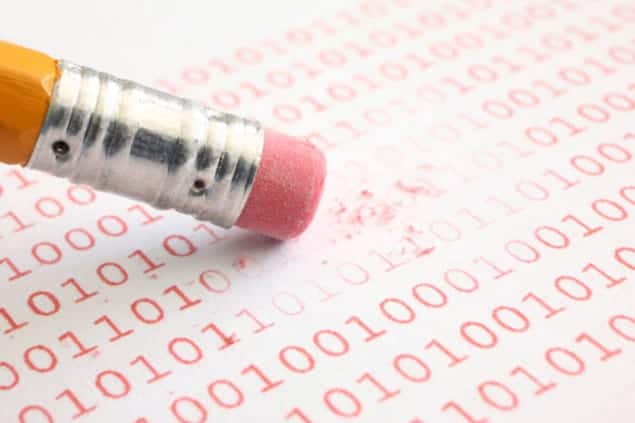
For the first time physicists have measured the tiny amount of heat released when an individual bit of data is erased. Although the value was first predicted more than 50 years ago, it is so small that measuring it has proved impossible – until now. The experiment, which involved trapping a tiny bead in a double well created by a laser and tracking its motion as it flipped between wells, places a lower limit on the energy dissipated by logic circuits, which could affect the design of future electronic devices.
For decades physicists and computer scientists have been making connections between thermodynamics and information theory. In 1961 the German–American physicist Rolf Landauer deduced that the irreversible erasure of information involves the dissipation of heat. “Landauer’s principle”, as it is known, applies to computing processes in which the number of bits of information decreases as the calculation progresses – something that happens in all conventional computers.
An important example of irreversible erasure is the “reset-to-one” process, whereby a bit holding information, which can be either 0 or 1, is reset to 1. As the information held by the bit is destroyed, this datum can no longer be recovered because, once the bit is set to 1, we have no way of knowing its previous value.
What has essentially happened is that the entropy – or randomness – of the bit has been reduced. And since the bit and its surroundings are physical entities that must obey the laws of thermodynamics, this entropy must be transferred from the bit to its surroundings as heat. In fact, according to Landauer’s theory, a minimum amount of heat – roughly 10–21 J per erased bit – must be dissipated when information is destroyed. Unfortunately, physicists have struggled to verify this prediction because 10–21 J per erased bit is less than a 1000th of the electrical energy dissipated when a modern silicon device is reset.
Tiny silica bead
Now, Eric Lutz at the University of Augsburg together with Sergio Ciliberto and colleagues at Ecole Normale Supérieure de Lyon and Raoul Dillenschneider at the University of Kaiserslautern are the first to confirm Landauer’s principle experimentally. Instead of using a silicon circuit, the team’s data bit comprises a tiny silica bead just 2 µm in diameter that is immersed in water and trapped using optical tweezers. The laser used to create the tweezers is alternatively focused at two different locations in rapid succession – creating two different locations where the bead can be trapped. The bit is assigned a value of “0” when the bead is in the left-hand position and “1” when it is in the right-hand position.
The system can be thought of as a classical particle that is trapped in two potential-energy wells with an energy barrier preventing the particle from jumping from one well to the other. If the barrier is very high compared with the bead’s thermal energy, the bead will never jump and the datum is stored. If the barrier is lowered to be on par with the thermal energy, then it becomes more likely that the bead will jump back and forth between 0 and 1. The physicists are also able to “tilt” the wells by raising the bottom of one relative to the other – ensuring that the bead always ends up in the lower well.
The experiment begins with the bit in a state in which it is equally probable that the bead is in the 0 or 1, which gives the system a non-zero initial entropy. The memory is then set to 1 by lowering the barrier, tilting the wells and then raising the barrier so that the bead cannot jump between the wells. After this reset process has been done, the value of the bit can only be 1 and therefore the entropy of the bit is zero.
Tracking the bead
Throughout this process, the position of the bead is monitored using a high-speed camera. This allows the team to calculate the energy dissipated as heat as the bead moves around. According to Lutz, this dissipation is caused by friction as the bead pushes against the surrounding water. The team also measured the heat dissipation associated with the tilting of the wells.
This process was repeated hundreds of times in order to obtain an average value for the amount of energy that is dissipated. The measurements were then repeated after changing the amount of time that was allotted for the erasure process to occur from about 5–40 s. The team found that as the time increased, the heat that was dissipated approached the limit predicted by Landauer. According to Lutz, this is in line with the laws of thermodynamics, which state that the erasure process must occur very slowly in order to be described by Landauer’s principle.
Now that Landauer’s principle has been verified, Lutz hopes that the energy-dissipation problem in electronic devices could be partially solved by devising erasure processes that are optimized to approach the Landauer limit. Indeed, if the ongoing miniaturization of electronics continues, designers could be creating circuits that operate near to the Landauer limit by 2035.
In the long term, the limit could be avoided by implementing “reversible” computing protocols that involve recovering the energy lost to heat – something that is possible but extremely challenging from a technical point of view.
The measurements are described in Nature.



